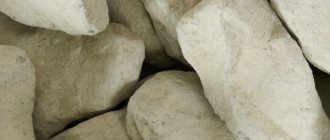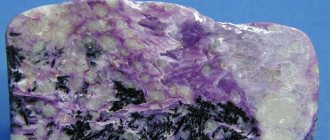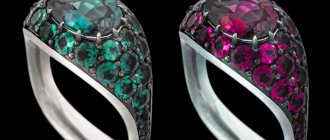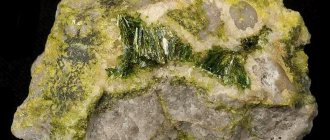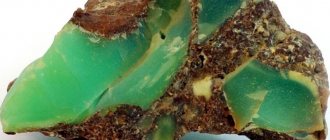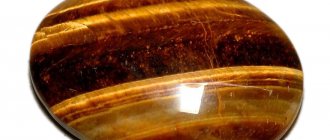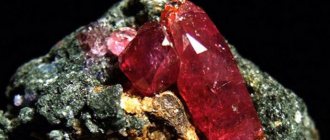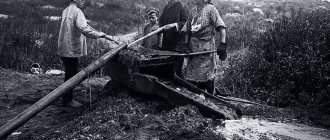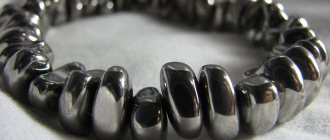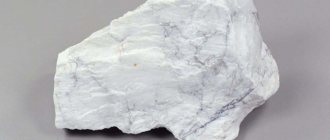Story
Ancient peoples knew about the properties of steatite.
The history of its use dates back thousands of years:
- Dishes made from it are found during excavations of the tombs of the pharaohs of Ancient Egypt and the habitats of the Scandinavian Vikings. The stone heats up quickly, retains heat for a long time, and is “indifferent” to the influence of potent ingredients (vinegar, seasonings, oils). It’s not for nothing that soapstone is known as “pot stone.”
- In regions with a harsh climate, steatite was used to make stoves and other heating devices - “stove stone” does not deform when heated.
- Residents of Suomi traditionally use the mineral as a heating pad, calling it a “hot stone” (“tulikkivi” in Finnish).
The most famous structure made of soapstone (on a reinforced concrete frame) is the statue of Christ. It towers over Rio de Janeiro, becoming a symbol of Brazil.
Statue of Christ in Brazil
The stone has many faces, which is enshrined in the names: wax, soap, ice stone, wen.
Place of Birth
Extraction of soapstone chlorite Deposits
of soapstone chlorite are found on almost all continents.
It is mined in industrial quantities in Finland, the USA, Thailand, China, India and Brazil.
Russia ranks second in terms of production volumes among all suppliers of the mineral. The largest deposit is located in Karelia - a mountain ridge runs from the borders of Finland to Medvezhyegorsk. Soapstone chlorite is also mined in the Urals in the Shabrovskoye deposit.
What is soapstone
In mineralogical registers it is listed as soapstone - a rock of metamorphic origin, a type of talc ore.
Typical soapstone looks ordinary:
- It is an opaque agglomerate of white, gray, brownish or greenish color. Rare examples of red or deep cherry shades.
- The shine is almost always matte-silky.
- Often the mineral appears fatty, which is why it is called “wen.”
One of the varieties is soapstone (saponite). This is a soft aluminosilicate, which, when dried, becomes brittle. Tailors love him.
Physico-chemical characteristics
Soapstone is a magnesium silicate with a complex, constantly changing chemical composition. It consists of three independent minerals - talc, magnesite and chlorite. The main share in the composition of soapstone is magnesite and talc - 40-50% each. The proportion of chlorite, depending on the location of extraction, can reach 8%.
Main characteristics of the mineral:
| Index | Description |
| Formula | Mg₃[(Si, Al)₄O₁₀](OH)₂ × Mg₃(OH)₆ |
| Mohs hardness | 2-3 units |
| Density | up to 3.2 g/cm³ |
| Thermal conductivity | 3.3 W |
| Specific heat | 0.98 kJ/(kg x K) |
| Shine | matte, greasy |
| Transparency | opaque |
| Melting temperature | 1640°C |
Soapstone has a discreet gray color with inclusions of white, green, brown, blue and yellow shades. Specimens of red and cherry color are considered rare.
Where and how it is used
Soapstone is in demand in the beauty industry and serious practical industries.
"Specialization" of raw materials
For each segment, the location of raw material extraction matters. When making stoves, a refractory and harder mineral from northern countries is chosen. Raw materials from other latitudes are suitable as an additive to ceramic and medical compositions.
Sculptors and stone carvers prefer soft Chinese, Thai, and African soapstone.
Industry
Technical raw materials are crushed and ground. It becomes a component of ceramic mixtures for refractories, electrical insulators, durable and heat-saving types of cement.
Used in the manufacture of products resistant to acids and other aggressive environments.
Bath stone
The production of bathhouse blocks has been launched. This is facilitated by the characteristics of steatite - thermal conductivity and heat capacity. When heated, it does not deform. Saunas, steam baths, and stoves made of soapstone are environmentally friendly, reliable (up to 1600°C), and do not dry out for hours.
Soapstone for baths
Soapstone has found application as a heat and sound insulator for floors and walls.
Jewelry and decor
The mineral is malleable to processing, after which its surface is silk-like. But it is too soft, which is why it is not very popular among jewelers. Pendants, pendants, and beads are made from it. This is the costume jewelry segment, the most expensive setting is silver.
Soapstone figurine
Much more often this is the source for small plastic items: animal figures, pyramids, balls. They are bought up by collectors and adherents of esotericism.
Stones for whiskey
Ornamental soapstone is becoming the main “player” in the status segment. We are talking about stones for cooling drinks.
They are used when you need to cool, but not dilute, an alcoholic or regular drink.
Advantages of whiskey stones over ice cubes:
- Do not dilute the drink.
- The cold lasts a long time.
- They are odorless, tasteless and do not interact with the drink.
2-3 hours before use, soapstone stones are placed in the freezer, then placed in a vessel with a drink. After use, rinse and dry.
Russian sellers offer material from Karelia. The cube stones are packed in stylish wooden boxes. The set looks elegant and is positioned as a status gift.
Other areas
In addition to tableware, larger products are made. For example, a budget replacement for marble is soapstone sinks for bathrooms or kitchens.
Powdered soapstone is used to enrich mixtures used by decorators and sculptors.
Properties of soapstone
The medicinal, magical and physicochemical properties of the rock determine its use.
Physicochemical characteristics
The composition of the mineral is variable, the main components of the rock are: talc - from 40 to 50%, magnesite - from 40 to 50%, chlorite - from 5 to 8%. Due to the high content of the latter, as well as quartz impurities, the hardness of steatite is three times greater than that of talc, which increases the strength of products containing it.
Hardness ranges from 1 to 5.5 on the Mohs scale. Soapstone is susceptible to mechanical damage, but can be easily restored by grinding. Other characteristics of the breed include:
- high heat capacity;
- heat resistance;
- structure density;
- low electrical conductivity;
- moisture resistance;
- resistance to acid solutions.
Only concentrated alkali can destroy the surface of the mineral.
Healing and magical properties
The mineral is in demand among lithotherapists because of its unique heat capacity. It is used as a natural heating pad. With its help, diseases of the musculoskeletal system are treated: osteochondrosis, sciatica, radiculitis.
Soapstone heated to 50 °C retains heat for an hour. A similar effect occurs during cooling. The cold mineral is applied to bruises and painful points due to inflammation of the joints.
In addition, the beneficial effects of soapstone are noted:
- to boost immunity;
- lowering blood pressure;
- concentration, increased perseverance;
- treatment of acute respiratory diseases;
- prevention of rickets.
The mineral is used by people involved in the occult. It is believed that a pendant with an insert wards off dark forces. Talismans in the shape of a ball or animal figures have great power, giving the ability to clairvoyance, opening a connection with the cosmos. Amulets with soapstone are intended for interaction with the subtle world.
According to Chinese belief, soapstone has yang energy and is a mandatory attribute of meditation.
Among the zodiac signs, the stone has favorites, as well as those for whom the mineral is categorically not recommended.
- It will help Gemini, Virgo, Libra, Pisces to become more confident and achieve harmony. At the same time, a talisman made by yourself will reveal the properties of the stone to the maximum.
- Cancers, Scorpios, Capricorns, Aquarius under the influence of the crystal become gullible and suspicious.
- The mineral is contraindicated for Aries, Taurus, Leo, and Sagittarius.
Therapeutic effect
Lithotherapists consider soapstone to be a natural biostimulant:
- The wavelength and frequency of vibrations are beneficial for the functioning of the brain.
- The mineral is used as a heating pad for exacerbation of radiculitis, osteochondrosis, and lumbago.
Soaptite “warmers” do not cool down for a long time and are not particularly massive.
- The usefulness of massage from heated steatite pebbles is recognized even by official medicine.
The Finns and other northern peoples wore beads or amulets around their necks as an amulet against illness or damage.
What is the difference from a fake?
Soapstone tiles 200*50*20
Soapstone is rarely counterfeited, using plastic as an imitation. It is quite simple to distinguish the original from the fake:
- soapstone is soft and easy to scratch and damage;
- this mineral has a heterogeneous color and discreet color;
- Soapstone leaves a white streak when rubbed across glass or other hard object.
Much more often soapstone is used to imitate jade because of its greenish color. The difference between the minerals is that the hardness of jade is higher compared to soapstone.
Methods of using the mineral
The structure of steatite allows it to be used to create various products, including:
- figurines;
- vases;
- Jewelry;
- dishes;
- decorative elements in the interior.
Wen is especially popular among jewelers. They value soapstone for its matte and silky surface and unusual color. Typically, the mineral is framed in silver to make necklaces, earrings and brooches.
Soapstone is often counterfeited as jade, because the ice stone is well colored. You can recognize the imitation by the strength of the rock. To distinguish soapstone from a fake, you should run it over dark-colored fabric. A noticeable mark on the material will indicate the natural origin of the mineral. However, it is pointless to fake the wen itself, because it is quite affordable.
Ice stone is widely used for construction and cladding. It is ideal for the construction of walls and masonry due to its physical qualities: durability, ease of processing, thermal conductivity and heat capacity.
The mineral is actively used for the construction of baths, fireplaces and stoves, because soapstone can withstand temperatures of more than 1500 degrees and is capable of releasing thermal energy for a long time. Soapstone is used to create warm floors in houses, swimming pools and saunas. When constructing furnaces, heat-resistant concrete is used, which contains wax stone.
The gem is often used by sculptors to create monuments and sculptures. Thus, soapstone was used to produce building material when casting a statue of Jesus Christ in Brazil.
Soapstone is even used in the food industry to cool drinks. So-called whiskey stones maintain the temperature of a cool liquid without changing its taste. However, the mineral should be washed after each use.
Despite the fact that soapstone is not a precious stone, it is a must-have in the collection of gem lovers. Moreover, acquiring it is not difficult.
Or maybe it's ice?
The opinions of true connoisseurs of the noble drink regarding the stones differed. Some people see in them much more show-off than benefit, and consider them just another advertising gimmick. There are those who claim that the stones leave a silicon aftertaste, or they don't like the way the cubes fall out into their mouth.
And yet the new accessory has enough adherents. Of course, for a party where drinks flow like water, you can’t stock up on any Whiskey Stones; it’s better to use good old ice. They are also not suitable for those who are used to diluted scotch or bourbon.
But if you like to slowly sip your favorite whiskey in close friendly company, these cubes will perfectly complement the pleasant ritual. What to choose is up to you.
Always yours, “Fragrant World”
Features of using soapstone tiles
Before heating a stove lined with soapstone, it is necessary to rinse the finishing surface thoroughly with water using a stiff brush. Then heat the oven well. You can water the stone cladding without fear that it will crack. At the same time, the soapstone will absorb part of the water and will gradually release light, uniform steam into the bathhouse.
Experts recommend using horizontal lining of the internal surfaces of the furnace, and vertical lining of the external planes. Thus, the furnace quickly heats up and cools down slowly.
